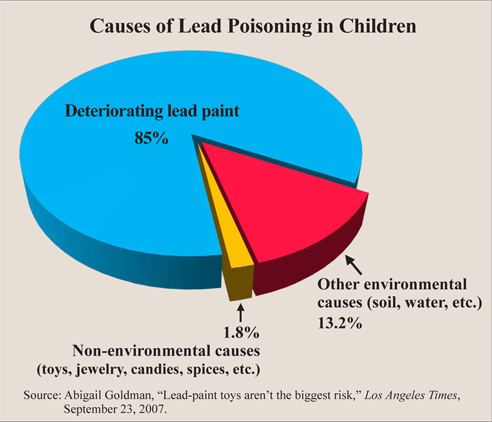Products intended for use by children may not contain lead amounts greater than 100 parts per million (ppm) starting in 2011. The Consumer Product Safety Commission (CPSC) has ordered manufacturers, distributors and retailers to reduce the lead content of children's products from the current standard of 600 ppm.
The new regulations were required by the Consumer Product Safety Improvement Act, which was passed hastily in response to 2007 recalls of toys imported from China. The law was intended to protect children (12 years old and younger) from lead poisoning, however, it targets products that pose a miniscule risk to children. It threatens to shutter small businesses, thrift retailers (including some large charities) and public libraries, and it limits the availability of consumer goods for children. Unless the law is modified, it is estimated that more than $1 billion of inventory will be destroyed, hurting producers, sellers, workers, consumers and the children the law was intended to protect.
Doesn't Regulate the Leading Causes of Lead Poisoning. According to the U.S. Centers for Disease Control and Prevention (CDCP), about 310,000 children are diagnosed with lead poisoning annually. The symptoms include impaired hearing, stunted growth and diminished intelligence. Over the 2000 to 2007 period, according to a Northwestern University study, most lead poisoning was due to ingestion of lead from the environment – contaminated soil or peeling house paint. Other significant sources of lead included dust, lead water pipes and soldered pipe fittings. The study found [see the figure]:
- About 85 percent of lead poisoning cases in children can be traced to deteriorating lead-based paint.
- Just 1.8 percent of lead poisoning cases are due to nonenvironmental causes, including toys, jewelry, candy, folk medicines and spices.
The new law does nothing to reduce the amount of lead in the environment, but encompasses products that pose no special risks to children.
Burdens Small Manufacturers. The new law requires manufacturers to test each batch of a children's product. Depending on how many components are tested, such third party tests cost $300 to $4,000 per batch. An elaborate product with a variety of colors and embellishments could be very expensive to test. Numerous items produced for children are inexpensive and their sales may not cover the testing costs. The Commission has stayed enforcement of testing requirements for one year, but rather than risking prosecution, some small manufacturers are choosing to cease production.
Endangers Motorsport Participants. There is no recorded instance of a child being poisoned by lead from children's vehicles. However, as with all powered vehicles, some engine components contain traces of lead. All-terrain vehicles (ATVs) and motorized dirt bikes designed for children are effectively banned. More than 50,000 motorized children's vehicles valued at $125 million will have to be destroyed or dismantled, according to the Motorcycle Industry Council.
Children who continue to ride off-road may instead operate vehicles designed for adults, which are more powerful and difficult to control. Approximately 90 percent of motorcycle fatalities and injuries among youths occur when they operate adult-sized vehicles.
The Commission has stayed enforcement of its regulations with respect to children's motor vehicles for one year to give manufacturers and sellers time to comply, and to allow Congress an opportunity to revise the law. In the meantime, however, manufacturers or retailers could still be prosecuted for violations by state attorneys general.
Harms Thrift Stores and Poor Consumers. The law also prohibits retailers from selling lead-tainted goods from existing inventories or used goods they acquire. Though the law does not require testing products for older children, such tests are a de facto requirement, because thrift stores can be prosecuted for selling tainted goods that might be used by younger children. Few resellers can afford to test all of their children's items; thus, many are discarding them:
- Goodwill claims it may have to destroy $170 million in merchandise.
- The Salvation Army estimates it may have to dispose of goods worth $100 million.
Many charities no longer accept donations of suspect goods because they cannot afford to test them for lead. Consequently, low-income consumers will lose access to affordable toys, books and clothing for children. Goods that would have been donated and reused – a form of recycling – will now be sent to landfills or incinerated.
Jeopardizes Libraries. The law also affects distributors of children's products, which include local and school libraries. The Commission has interpreted the law to include any children's book printed before 1986, when lead-based ink was used. CDCP researchers say there is virtually no danger of a child suffering lead poisoning from books; nevertheless, the Commission has advised libraries to deny children access to books printed before 1986.
Libraries are often underfunded, and testing books for lead is extremely expensive. One Idaho librarian estimates lead testing will cost her public library as much as $4 million. Many libraries are simply rejecting any donated children's books published before 1986. Small town libraries, which depend on donations to stock their shelves and for book sales to raise funds, will be severely impacted.
Conclusion. The new law does not combat the leading causes of childhood lead poisoning. It effectively criminalizes the production, sale or loan of many common children's products. Congress should revisit this issue and lift the restrictions on the resale of old children's books and toys. Rather than pursue phantom risks of lead exposure, Congress should focus on the single item that poses the highest risk of lead poisoning to children: deteriorating paint in older houses.
H. Sterling Burnett is a senior fellow and Michael Hand is a research assistant at the National Center for Policy Analysis.